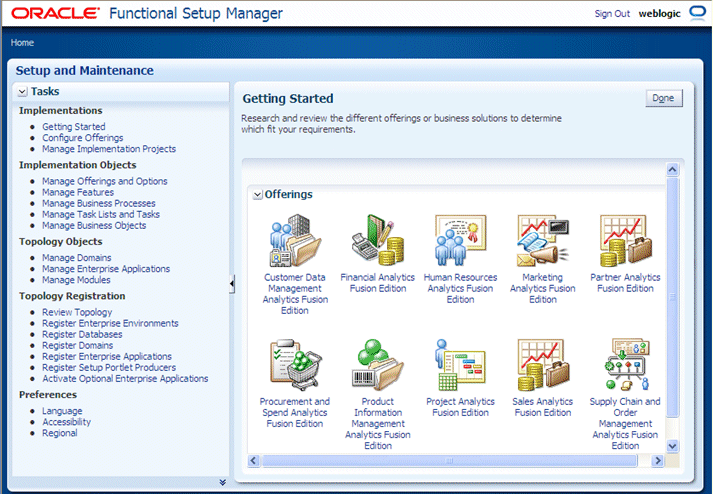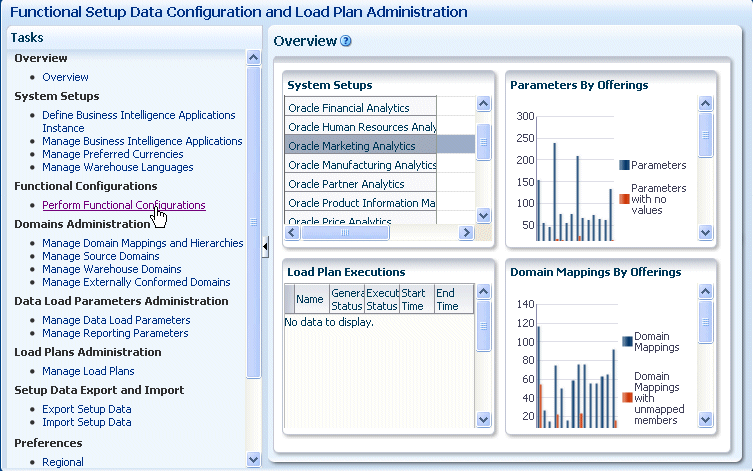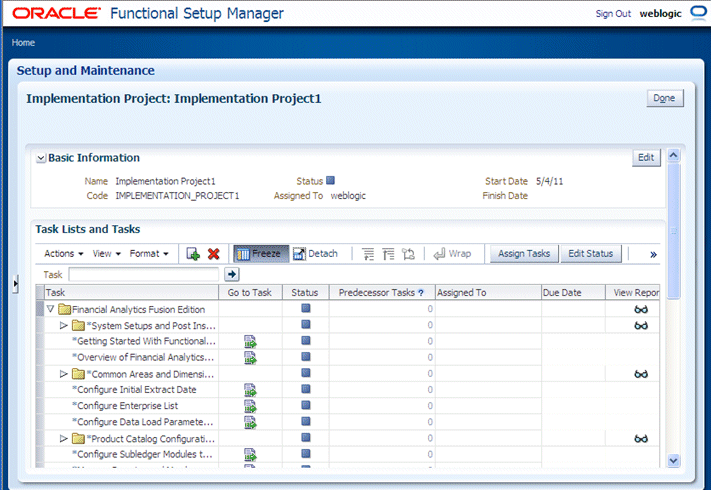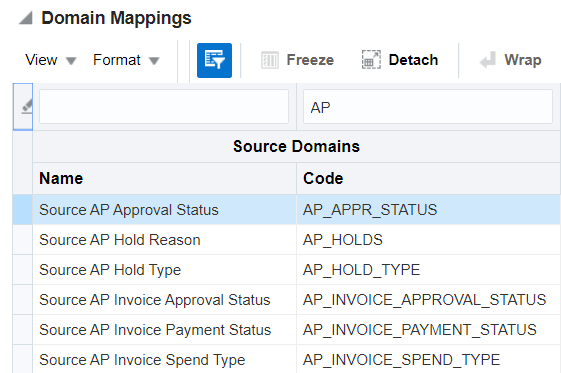1 Overview of Functional Configuration in Oracle BI Applications
Functional configuration in Oracle Business Intelligence Applications (Oracle BI Applications) includes setup and management of the environment and configuration of Offerings and Functional Areas.
Tip:
To get started quickly with functional configuration, follow the high-level steps in Roadmap for Functional Configuration.This section helps in familiarizing yourself with the concepts, tools, and workflows related to Functional Setup Manager (FSM) and Oracle BI Applications Configuration Manager (Configuration Manager).
Terminology
Here’s a brief description of the terminology that is used in the Oracle BI Applications context.
-
Source Instance — The transactional system (that is, OLTP) that serves as the source of data for Oracle Business Analytics Warehouse. To read and analyze data from a source system, you must register it with Oracle BI Applications. You can do so by using Configuration Manager.
-
BI Application Offering — A BI Application product that you have purchased, for example, Oracle Financial Analytics or Oracle Sales Analytics. To start using a BI Application Offering, you must first enable it in Configuration Manager.
-
Functional Area — A component of a BI Application Offering. For example, the Oracle Human Resources Analytics Offering has Functional Areas: Workforce Effectiveness, Leave & Accrual, and Workforce Development. A Functional Area is the smallest unit that can be configured in a BI Application Offering.
Overview of Configuration Manager and Functional Setup Manager
Use these tools to perform functional configuration for Oracle BI Applications.
Configuration Manager
-
Contains the setup objects for Oracle BI Applications.
-
Provides an administrative user interface for setup and configuration tasks.
-
Enables migration of setup data across environments.
-
Recommended tool for ongoing administration and maintenance of functional setups.
-
Enables a quick review of the setup values for troubleshooting.
Functional Setup Manager (FSM) for Oracle BI Applications
-
Used by Configuration Manager to provide a task-based implementation process, where an administrator is guided through a series of tasks to configure a Functional Area and manage its dependencies.
-
Provides phased implementation capability.
-
Launched from Configuration Manager to perform functional configurations.
-
Recommended tool for initial implementation.
-
Invokes Configuration Manager for setup tasks.
-
(For Fusion Applications users) FSM for Oracle BI Applications is different from the Oracle Fusion Functional Setup Manager. FSM for Oracle BI Applications includes only features that are applicable for the Oracle BI Applications functional setup.
What is Configuration Manager?
Configuration Manager is a web application for setting up and maintaining an Oracle BI Applications environment.
For functional configuration, Configuration Manager works in conjunction with FSM, which provides guided tasks to configure Offerings and Functional Areas. See What is Functional Configuration?
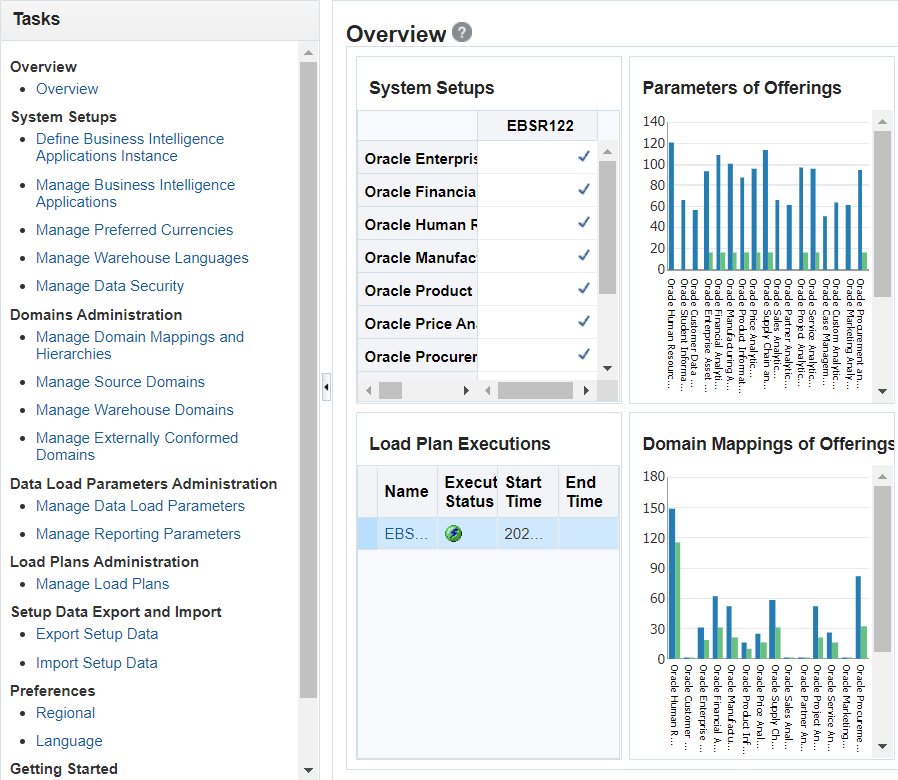
Description of the illustration 103-what-is-cm.gif
Configuration Manager enables you to do the following:
-
Launch FSM to configure Offerings and Functional Areas (for example, by specifying Domain Mappings, Data Load Parameters, and Reporting Parameters).
FSM provides a list of guided tasks that enable you to configure Oracle BI Applications Modules and Functional Areas. For example, a functional developer may use a task named 'Configure Initial Extract Date' to set the value of INITIAL_EXTRACT_DATE to '2005-01-01'.
-
Monitor and manage setup data, and extend Oracle Business Analytics Warehouse, where necessary.
For example, a functional developer may have set the value of INITIAL_EXTRACT_DATE to '2005-01-01'. To change this value to '2006-01-01', you can edit the parameter in the Manage Data Load Parameters tab in Configuration Manager.
-
Monitor and manage load plans that you use to perform ETL.
See Overview of Load Plan Life Cycle in Oracle Business Intelligence Applications ETL Guide.
-
Migrate configuration data across environments.
See About Exporting and Importing Setup Data for Configuration Manager.
What is Functional Setup Manager?
Functional Setup Manager (FSM) for Oracle BI Applications enables you to configure and manage tasks for Offerings and Functional Areas. Examples of FSM tasks are 'Configure Initial Extract Date', and 'Configure Global Currencies'.
FSM is installed and deployed as part of Oracle BI Applications. In FSM, you select an Oracle BI Applications Offering and its Functional Areas for deployment, and then create an implementation project for that Offering. FSM generates a list of configuration tasks for the selected Offering and Functional Area(s). You can then assign these tasks to different functional developers, and monitor the status of the implementation project. The setup screens in FSM guide functional developers through all the tasks that must be performed.
How to launch FSM
In Configuration Manager, select the Perform Functional Configurations link. When prompted, specify a user name with appropriate privileges for the tasks that you want to perform. For example, to create an Implementation Project and assign Tasks to Functional Developers, connect as a user with 'BI Applications Implementation Manager' privileges. See About Users and Roles in Configuration Manager.
When you launch FSM as a user with the Oracle BI Applications Administrator role or the BI Applications Implementation Manager role and open an Implementation Project, you see the functional tasks that relate to the Offering being deployed by that Implementation Project.
The following example screenshot shows the functional tasks for Oracle Financial Analytics.
Getting Started With Configuration Manager
To configure Offerings and Functional Areas, you must log in to Configuration Manager. To help administrators perform tasks easily, this tool includes User Assistance, Help, Documentation, and other resources.
Logging In to Configuration Manager
You use Configuration Manager to set up and manage several aspects of the Oracle BI Applications environment, and to manage and monitor functional configurations for Oracle BI Applications Offerings.
Viewing Help Content
Configuration Manager provides Help and User Assistance features.
-
Context-sensitive Help - Click the Help icon on any dialog to view context-sensitive Help for that dialog. When the context-sensitive Help is displayed, use the Table of Contents, Index, and Search facilities to locate User Assistance on other areas of the product.
Tip:
To maximize the text pane in the Help window, choose Maximize Reading Pane from the View menu. Alternatively, use the Collapse Pane arrow (shown in the screenshot) to hide the left hand tabs, or use the vertical sizing bar (above the Collapse Pane arrow) to reduce the width of the tabs.
Description of the illustration 103-view-help.gif -
Inline Help, such as mouse-over tool-tips - Hold the cursor over an object to view a tool-tip for that object.
Tip:
For convenience, the same help content that is available in the UI is also available as a guide: Oracle Business Intelligence Applications Functional Configuration Reference.About Users and Roles in Configuration Manager
To access Configuration Manager or FSM, you must log in as a user with one of these Duty Roles:
-
BI Applications Administrator
Users with the BI Applications Administrator Duty Role have access to all Configuration Manager screens and all FSM screens. Only users with this Duty Role can perform system setup tasks such as managing the Oracle BI Applications instance and enabling Oracle BI Applications offerings.
-
BI Applications Developer
Users with the BI Applications Functional Developer Duty Role have access to all Configuration Manager screens except for the System Setup screens. In FSM, these users have access to the list of functional setup tasks assigned to them, and they can perform functional setup tasks (by using the Go to Task option in FSM).
-
BI Applications Implementation Manager
Users with the BI Applications Implementation Manager Duty Role have access to the Oracle BI Applications Configuration Manager Overview page and dialogs for the export and import of Setup Data. In FSM, these users have access to the Configure Offerings and Manage Implementation Projects screens, but they cannot perform functional setup tasks. That is, they do not have access to the Go to Task option in FSM.
Setting up users with these Duty Role privileges is performed when Oracle BI Applications is set up. To set up user access, see User Access to Configuration Manager, FSM, and Oracle Data Integrator in Oracle Business Intelligence Applications Installation Guide.
To find out what Duty Role privileges have been assigned to the different users, use your LDAP tools and Oracle APM and check which users have the Duty Role privileges BIA_ADMINISTRATOR_DUTY, BIA_IMPLEMENTATION_MANAGER_DUTY, and BIA_FUNCTIONAL_DEVELOPER_DUTY. See Configuration Manager Permissions Reference in Oracle Business Intelligence Applications Security Guide.
About Setup Objects in Configuration Manager
Configuration Manager data includes these Setup objects.
-
Data Load Parameters — used to control the nature of data loaded from the transactional system into the Oracle Business Analytics Warehouse. Examples: INITIAL_EXTRACT_DATE, TIME_GRAIN.
-
Domain Mappings and Member Mappings — used to map a Source column List of Values to a Warehouse column List of Values. Example: Domain Maps for the Employee Dimension: COUNTRY -> W_COUNTRY.
-
Reporting Parameters — correspond to Dynamic Repository Variables in the repository and allow these variables to be set using Configuration Manager. Example: FSCM_MASTER_ORG.
About the Main Task Areas in Configuration Manager
Configuration Manager has these main task areas:
-
System Setups — Includes options to set up Source Systems, Target Databases, Warehouse Languages and so on.
-
Functional Configuration — Includes the Perform Functional Configurations link, which you can use to invoke FSM to perform Functional Configuration.
-
Setup Data Maintenance and Administration — Includes options to monitor the configuration settings that your Functional Developers have made using FSM, and to make changes where required. For example, a Functional Developer may have used a Task in FSM to set the value of INITIAL_EXTRACT_DATE to '2005-01-01'. If you want to change this value to '2007-01-01', you can use the Manage Data Load Parameters tab in Configuration Manager to edit the value directly, instead of reassigning the Task in FSM.
-
Export and Import Configuration — Includes options to back up your setup data and migrate it to a separate environment.
About Functional Setup Tasks in FSM
FSM has four types of Functional Setup Tasks.
-
Tasks to configure Data Load Parameters. For example, the task ‘Configure Initial Extract Date’ displays Data Load Parameter INITIAL_EXTRACT_DATE.
-
Tasks to manage Domains and Mappings. For example, the task ‘Manage Domains and Member Mappings for Employee Dimension’ displays Domain Maps for the Employee Dimension.
-
Tasks to configure Reporting Parameters. For example, the task ‘Configure Reporting Parameters for Master Organization’ displays Reporting Parameter FSCM_MASTER_ORG.
-
Tasks that provide information. These tasks may be:
-
A set of instructions for editing components using tools other than Configuration Manager. For example, to configure the BI Metadata Repository, you use Oracle Business Intelligence Administration Tool. The names of these Tasks are prefixed with ‘How To’.
-
Conceptual, overview or supporting information. For example, the task ‘Overview of Financial Analytics’ provides information about Functional Areas in this offering.
-
About the Work Area in Configuration Manager
Configuration Manager has a main Tasks bar and a Functional Configuration work area for Domains and Mappings.
To set accessibility preferences, click the Accessibility link in the top right hand corner to display the Enable Accessibility Preferences dialog. For example, you might want to display high contrast colors, or use large fonts.
Configuration Manager Menu Options Reference
Configuration Manager uses these menus and options.
| Icon or Menu Option | Description |
|---|---|
|
|
Actions Use the Actions menu to display a list of available options for the currently selected object. For example, common actions are Enable, Disable, Add, and Edit. |
|
|
View Use the View menu to select which columns to view, and re-order columns. |
|
|
Format Use the Format menu to either resize the selected column or to wrap the content in the selected column. |
|
|
Freeze Use the Freeze icon to ensure that the selected column is fixed in its position and is visible even when you scroll the table horizontally. |
|
|
Detach Use the Detach icon to view a table tab in a separate larger pane. * For example, use this option to view data in wide columns more easily. To re-attach a separated pane, click Detach again. |
|
|
Wrap Use the Wrap icon to wrap the content in the selected column. When a column has a lot of content, by default only a part of it is displayed in the table. The Wrap option enables you to view the entire text in the column. |
Note:
*If you are editing a master-detail table, the Detach option does not detach the master-detail relationship.Configuration Manager Icons Reference
Configuration Manager uses icons to provide quick access to the most popular functions.
| Icon or Menu Option | Description |
|---|---|
|
|
Add Use the Add icon (or plus sign +) to add an object. For example, click the Add icon on the Define Oracle BI Applications Instance - Source Systems tab to add a new Source System. |
|
|
Set parameter value before full data load This icon indicates that the value of a Data Load Parameter must be set before you perform a full load of data from the source instance to Oracle Business Analytics Warehouse. |
|
|
Edit Use the Edit icon (or pencil symbol) to edit the object that is currently selected in the table. For example, click the Edit icon on the Define Oracle BI Applications Instance - Source Systems tab to edit the currently selected Source System details. Alternatively, click on the value in the Parameter Value column to edit the value. |
|
|
Global Parameter This icon indicates that the parameter is global (that is, it applies to all (or a majority of) ETL tasks). |
|
|
Go To Top Use this icon to display the all nodes in the domain hierarchy. |
|
|
Go Up Use this icon to display the next highest level of nodes in the domain hierarchy. |
|
|
Overridable Parameter This icon indicates an overridable Application Specific parameter. An Overridable parameter icon indicates that each associated Fact Group or Dimension Group can have a different value. |
|
|
Parameter This icon denotes a parameter. For Data Load Parameters, if displayed in the Data Load Parameters pane (or top list), then this icon indicates an Application Specific parameter. If displayed in the Group Specific Parameter Values For pane (or lower list), then this icon indicates a Non-Overridable Application Specific parameter, which means that each associated Fact Group or Dimension Group must have the same value. In other words, if you change the value for one Fact Group or Dimension Group, then all Fact Groups and Dimension Groups are updated with that value (if you first confirm at a Warning dialog). |
|
|
Show as Top Use this icon to display only the currently selected parent node and child nodes. * |
|
|
Read Only Parameter This icon indicates that a Data Load Parameter value is read-only, which means that you cannot change that parameter value on the Manage Data Load Parameter dialog. |
|
|
Parameter Category This icon denotes a grouping of related parameters, for example, the Configure Time Dimension category is a group of parameters that are related to calendars. To expand a Parameter Category, click Expand: To collapse a Parameter Category, click Collapse: |
|
|
Query By Example Use the Query By Example icon to toggle the display of the Query By Example fields above each display column. When Query By Example fields are displayed, enter a value into a Query By Example field and press [Enter] to search for records that match that value. To clear a query, clear the text in the Query By Example field and press [Enter] again. For example, to search for parameters with names beginning with Global, type Global in the query box above a Name column, then press [Enter]. To clear the query, clear the text 'Global' from the query box above the Name column, then press [Enter]. |
|
|
Select Date Use the Select Date icon to toggle the Calendar pane, which enables you to select a date. For example, on the Export Setup Data tab, select January 1 2010 to display only files that were exported on that day. |
|
|
Start Search Use the Start Search icon to display parameters matching the value or wildcard specified in the adjacent text box. |
Note:
*This icon is only active for child nodes.Tip:
To see a tool tip for an icon, mouse-over the icon.
About Sorting Items
To change the sort order of displayed items, click on or mouse-over the field name on which you want to sort, then click the up arrow or down arrow that is displayed in the field label.
Sort options are only displayed on mouse-over or when a field label or column is selected. For example, to display domain names in descending alphabetical order, you might click on the Name field label and click the down (or Sort Descending) arrow.
